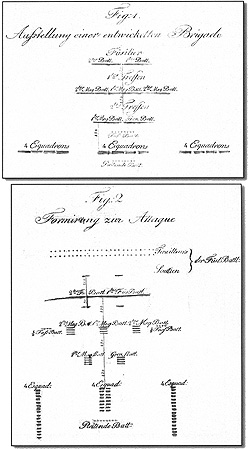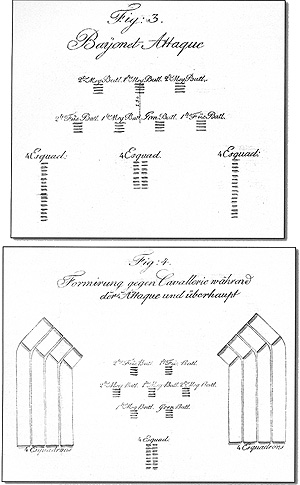Regulating Battalions: The Prussian Way
Introduction
by Jeff Lewis, UK
| |
The Dragoon regiment or Cuirassier stood in the middle of the Cavalry Line. The Light cavalry took position on the wings with the oldest regiment of the Light Cavalry on the right. The Foot battery was located in Lager behind the two reserve battalions. The Horse battery stood behind the middle Cavalry regiment. This arrangement was not an informal suggestion, it was a fairly strict layout. The regulations dictate several times that this exact formation is to be used unless there are special circumstances that forces a different arrangement of troops. The arrangement is to be used not just on the battlefield but also when marching to camp or bivouac. Although allowing that changes might need to be made due to the terrain or the enemy it is clear that such changes needed to have a clear logical need behind them in order to stray from the regulated arrangement. Indeed it is even stated that if battalions are to be placed in a single line for Parade a special instruction must be issued to allow this. Concerning the strength of a Brigade it is also added that even if less battalions than a Brigade strength are present they must follow the same Brigade distances, and generally obey as closely as possible the arrangement given. This would also apply if extra battalions or other units were present. The skirmish part of this formation is admonished to stay at all times in contact with the main force and not to become separated during battle and so leave the main troops without skirmish cover. A particular problem the regulations state “with the Germans in the last war” presumably meaning the Austrians in 1809. That said it is also accepted that the Fusiliers are sometimes deliberately away on detachment for special duties, in which case their position is taken by the platoons formed from taking out the third rank of the battalions in the first battle line. These extra formations might also be formed even when the Fusiliers are present to provide extra numbers and width to the reserve battle line. There is actually a long section in the regulations devoted entirely to the creation and uses of the platoons from the third rank preceding those for Brigade arrangement. In combination the above side explanations show that it would, for instance be possible to follow this arrangement with just three battalions. The senior battalion would be the reserve battle line, the platoons of the third rank from the two junior battalions could take position as the Fusilier contingent and the two junior battalions themselves forming the main battle line. Any accompanying artillery and cavalry taking position following the guidelines in a similar fashion. A smaller force of cavalry would keep to the left, right, and middle groups for the rear cavalry line by using smaller units to form each of them. This covers the static arrangement of the troops, the procedures for manoeuvring the Brigade and how each battalion was to know what do was also laid out. The Brigade General determined and allocated the battalion which would give the direction and position change that the other parts of the Brigade would follow. Any required evolutions for each battalion in following the Brigade changes would be made following the principles of section 3 in the main regulations, which details how a battalion changes position or formation.
In regulating battalion movements it was thus simplified for the Brigade Commander, all he needed to do was to issue instructions, or more probably lead, one Battalion in the required movement and the rest of the Brigade would follow along in the required arrangement without the Brigade commander needing to issue lots of orders or inform each Battalion Commander what was intended. Battalions taking individual actions changing the layout of the Brigade minute to minute were just not catered for. Special circumstance could naturally amend this, but rather than a license to ignore the regulations it more reinforced how unusual this should be, and needed specific instructions from the Brigade Commander as the Brigade arrangement was designed to meet the majority of needs. The Prussians had many years of experience to draw on when these regulations were drawn up, as well as their observations of the effectiveness of similar formations in other armies (note the comment on the last war). There were no urgent revisions published to override them following experience of use in 1813-1814. In this respect the Brigade formation laid out in the 1812 Prussian regulations could be used on a game tabletop not to dictate what players of Prussian armies are allowed to do, but more as a test of the validity of the wargame rules themselves. If the rules penalise arrangements that follow the principles of this structure for Prussian troops we can be fairly certain there are flaws in the essential rule system. Although there are celebrated events where individual officers appear to have taken initiative without regard to the normal arrangement, there are at least as many disasters of inappropriate action. In addition the very fact that the successes are celebrated suggests the rarity of occurrence. It would seem appropriate that if such initiative is to be encouraged in a table top army then it would need to contain a large element of randomness with battalions taking disastrous actions against a players wishes at least as often as they follow wishes from on high. This covers each battalion’s regulated place within a Brigade generally, which of course is missing the hardest test of all, the chaos of combat, which is where we will look at their regulation in part 2. Bibliographyanon, Reglement vor die Königl. Prußische Infanterie, Potsdam 1726
Regulating Battalions: The Prussian Way Back to Table of Contents -- First Empire # 78 Back to First Empire List of Issues Back to MagWeb Master Magazine List © Copyright 2004 by First Empire. This article appears in MagWeb.com (Magazine Web) on the Internet World Wide Web. Other articles from military history and related magazines are available at http://www.magweb.com |
 The two Fusilier Battalions from the Advance Guard were placed
in front of the first main battle line. The first battle line consists of three
battalions; the second battle line, also termed the reserve, contained the
two senior battalions Grenadier battalion and the first battalion of the
oldest infantry regiment. The Cavalry formed the rear battle line.
The two Fusilier Battalions from the Advance Guard were placed
in front of the first main battle line. The first battle line consists of three
battalions; the second battle line, also termed the reserve, contained the
two senior battalions Grenadier battalion and the first battalion of the
oldest infantry regiment. The Cavalry formed the rear battle line.
 Changes to front for the Brigade were carried out following the
shortest route, only the battalion pivoting around the axis would wheel
around that point, the remainder would go more directly to their position
defined by the regulation rather than forming a huge Brigade wheel in entirety.
Changes to front for the Brigade were carried out following the
shortest route, only the battalion pivoting around the axis would wheel
around that point, the remainder would go more directly to their position
defined by the regulation rather than forming a huge Brigade wheel in entirety.